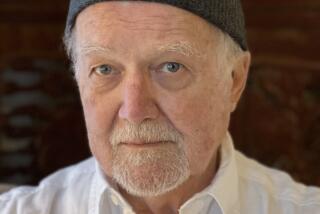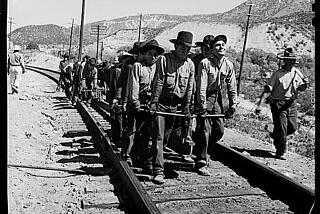Futurist Provides Fuller Explanation for Passengers on Spaceship Earth
When Lloyd Steven Sieden started working for the Friends of Buckminster Fuller in 1983 as a volunteer helping to set up speaking engagements for the renowned futurist-philosopher, Sieden hoped to get to know Fuller on a personal basis.
But, as Sieden says, the legendary inventor of the geodesic dome “had the audacity to die” a few months after Sieden started working, and he never got a chance to know him.
Six years after Fuller’s death at age 87, however, the San Juan Capistrano “futurist” management consultant and lecturer on Buckminster Fuller’s ideas feels as though he’s on intimate terms with the man who was known as “the Leonardo da Vinci of our time.”
Sieden spent five years writing and researching a book on Fuller, who dedicated 50 years of his life to creating modern technologies and a philosophy of global cooperation that would benefit everyone on what he called “spaceship earth.”
The result is “Buckminster Fuller’s Universe: An Appreciation” (Plenum; $24.95), a 511-page tome that the publisher says “follows Fuller’s life in order to translate his complex ideas into clear, accessible language.” The book includes a forward by Fuller’s longtime friend, writer and philosopher Norman Cousins.
To write his book, Sieden watched and listened to hundreds of hours of video and audiotapes of Fuller’s “thinking out-loud sessions,” as Fuller called his lectures.
It was not an easy task. Sieden said he would have to replay portions of the tapes several times in order to distill Fuller’s complex, frequently meandering thoughts.
“It became almost as though he was living in the house--that’s how my wife felt,” said Sieden, 40, with a laugh. “I felt that way, too. It was almost like he was sitting on my shoulder whispering, ‘No, that’s not what it is.’ I’d think I understood an idea and in another audiotape realize, ‘No it’s like this. ‘ “
Sieden said Fuller “spoke in huge, long sentences,” frequently taking 20 minutes to connect the points he was making, “so it was difficult to understand. Most people who listened to him would know what I’m talking about. He was a great, great, great thinker. He was not the best communicator. That was not his strong suit, and he never claimed it to be. He said he was thinking out loud.”
Although Publisher’s Weekly calls “Buckminster Fuller’s Universe” an “absorbing biographical study,” Sieden emphasizes that his book is not, in the strictest sense, a biography because it does not go into every intimate detail of Fuller’s life. “When people ask me about the book, I say it’s more a translation of his thoughts than anything else,” Sieden said.
The book grew out of educational programs about Fuller that Sieden began conducting for the Buckminster Fuller Institute in Los Angeles a few months after Fuller’s death.
Sieden was at a loss whenever audience members would ask him to recommend books so they could learn more about Fuller. He said all of the books that had been written by or about Fuller tended to be written in the same complex manner in which Fuller spoke. “The reader would often lose interest because they were so detail oriented,” he said.
“Buckminster Fuller’s Universe,” Sieden said, “is the first book that looks at the man and his ideas from the perspective of his whole life. When you look at his life from that perspective, I saw a lot of things that nobody noticed: There were very specific stages in his life.”
The turning point in Fuller’s life came in 1927, a time when he was contemplating suicide following a string of unfortunate events that included the death of his young daughter and increasing debt due to a failed business venture in which he had lost his family’s and friends’ money.
But, Sieden said, Fuller experienced a mystical event which transformed his life and overall perception. During the incident, Fuller claimed to have heard a voice which told him he had no right to kill himself--that he belonged not to himself, but to the universe. Fuller said the voice went on to tell him that he should convert his experiences “to the highest advantage of others.”
As Fuller once explained, his goal in working to benefit humanity was “to find ways of doing more with less to the end that all people, everywhere, can have more and more of everything.”
The man who had been expelled from Harvard twice went on to earn 47 honorary degrees, invent synergetic geometry, hold more than 25 patents, write thousands of articles and author 27 books, including his perhaps best-known work, “Operating Manual for Spaceship Earth.”
Fuller’s most famous invention is the geodesic dome, a strong web of lightweight triangles which, as Sieden says, “encloses the most space with the least amount of material.”
Although the geodesic dome has mostly been used for commercial purposes, Sieden said Fuller envisioned the domes being used for human shelters. He even talked about building a geodesic dome high above Manhattan which, Sieden said, could save millions of dollars in heating and cooling costs. “People haven’t touched the tip of the iceberg of what you can do with the geodesic domes yet,” he said.
“Although most people think Fuller’s greatest contribution was his inventions, in my opinion it was his discovery of what he called the generalized principles that govern all (the) universe,” said Sieden, explaining that a generalized principle “is something that applies everywhere in the universe, such as the principle of least resistance.”
Sieden said Fuller believed that if people operated in accordance with these natural laws, rather than trying to violate them, “our whole system would be much more productive, cooperative and successful for everyone.”
Sieden said “global cooperation” was one of Fuller’s primary topics of discussion. “He was talking about the fact that humanity has reached a point where we have to really take control of what we’re doing and be responsible for it. . . . People are beginning to see we need to work with the environment, not conquer nature.
“Basically, what we’re talking about is cooperation rather than competition--broadening your perspective--to think globally. There’s a phrase today: ‘Think globally, act locally,’ and Fuller was talking about that 40 years ago. His perception of the way the world works is more valid now than it ever was.”
Sieden said “Buckminster Fuller’s Universe” is being carried in most bookstores, but because Plenum is a medium-size publisher, distribution is slow. Those who are unable to find the book can order a copy from Sieden at (714) 248-1139.
Book Signing: Scott Sutton, author of “The Family of Ree Series,” will sign from 10:30 a.m. to 12:30 p.m. July 15 at Half Magic children’s bookstore, 13011 Newport Ave, Tustin. For more information, call (714) 731-6020.
More to Read
Sign up for our Book Club newsletter
Get the latest news, events and more from the Los Angeles Times Book Club, and help us get L.A. reading and talking.
You may occasionally receive promotional content from the Los Angeles Times.






